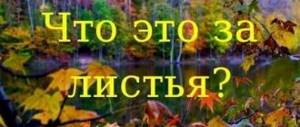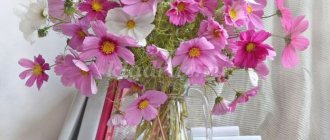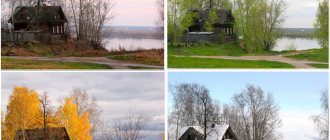Lesson summary on the surrounding world in 2nd grade with a presentation on the topic: Mushrooms
Lesson on the surrounding world in 2nd grade on the topic: “Mushrooms”
Lesson topic: “Mushrooms” Purpose: to introduce students to the kingdom of mushrooms. Lesson objectives: subject: study the structure of the mushroom; show the variety of mushrooms; teach to distinguish edible mushrooms from inedible and poisonous ones; meta-subject: teach to accept and maintain an educational task, analyze objects, make comparisons and classifications, develop thinking, speech, imagination, horizons, cognitive interest of students; cultivate a caring attitude towards the nature of your native land and your health; learn to accept different opinions and cooperate. Create conditions for the formation of UUD: personal – express a positive attitude towards the process of cognition; show kindness, trust, attentiveness, and help in specific situations; perceive the speech of the teacher (classmates) not directly addressed to the student; regulatory – analyze the emotional state obtained from successful (unsuccessful) activity; cognitive – reproduce from memory the information necessary to solve a learning task; check information; make assumptions, discuss problematic issues; communicative – perceive the text taking into account the task at hand, find in the text the information necessary to solve it; compose small oral monologues; listen and understand the speech of others, negotiate with classmates together with the teacher about the rules of behavior and communication and follow them. Planned results: • understand why mushrooms are classified as a special kingdom of living nature;
• get acquainted with the structure of mushrooms; • learn to distinguish edible mushrooms from inedible and poisonous ones. Type of lesson: learning new material Methods of work: explanatory and illustrative, partially search, verbal, visual, practical. Forms of work: frontal, individual, pair. Equipment: computer; projector; interactive board; textbook “The world around us” 2nd grade; presentation "Mushrooms"; pictures with different varieties of mushrooms; paper baskets for children; signal cards (blue, red and green); student messages. Lesson scenario
I. Organization of the beginning of the lesson. - Let's start our lesson. Check if you have everything on your desk: textbook, notebook, pencil case. Emotional mood. Greeting game "Hello!" - Guys, let's greet each other and wish everyone good luck in the lesson. Students take turns touching the same-named fingers of their neighbor’s hands, starting with the thumbs, and say: I wish (they touch their thumbs); success index); large (medium); in everything (nameless); and everywhere (little fingers); Hello (Touch with the entire palm of the hand). The students repeat the actions a second time, but after the little fingers meet, the fingers intertwine and the phrase “Good luck in your lesson!” is said. II. State the topic and purpose of the lesson. - Name the kingdoms of living nature. (slide No. 1). — Bacteria, animals, plants, fungi. - Listen to the riddle and guess: The whole Antoshka is a hat and a leg. It will rain - He will grow. (Slide No. 2) Did you guess the riddle? (Children's answers). This is a mushroom. What words of the riddle gave you the answer? (Children's answers). Which kingdom of living nature do they belong to? (Kingdom of Mushrooms). What do you think is the topic of today's lesson? (The topic of our lesson is “Mushrooms”). - Think about what we need to know about mushrooms? (slide No. 3) - Today you will find out whether all mushrooms can be collected, what structure a mushroom has, what danger mushrooms pose, learn to distinguish an edible mushroom from a poisonous one. III. Getting to know new material. (slide No. 4) In the dictionary of S.I. Ozhegova wrote: “Mushrooms are a special organism that does not form flowers or seeds and reproduces by spores.” -What are mushrooms? (These are special living beings, the kingdom of nature) For a long time, scientists could not decide what mushrooms even are? - Which kingdom of nature do you think they belong to? (children's answers) (special kingdom) (They do not fit into groups of animals and plants). (Slide No. 5) In the old days, many thought that mushrooms appeared from dew, from lightning strikes, from rotting substances. And in the 19th century they were separated into a separate kingdom. There are 200 species of mushrooms in our country. Mushroom pickers collect 15 species, and avid mushroom pickers take up to 25. Mushrooms are called vegetable meat. In terms of nutritional value, they are superior to many foods we know: meat, fish, sausage, eggs. Equally important is the presence of fats, carbohydrates, vitamins, and mineral salts. (Slide No. 6) The underground part of the mushroom is called mycelium, a web-like plexus of threads. It absorbs water from the soil with nutrients dissolved in it. For the mycelium to grow, it needs heat, air and moisture. The mycelium can divide, grow, capture new territories and produce new offspring. The fruiting body is what we incorrectly call a mushroom. The fruiting body consists of a stem and a cap; they reproduce using spores. (Slide 7) The science of mycology studies the kingdom of mushrooms, which includes at least 100 thousand species. There are different types of mushrooms. Some with caps are cap mushrooms. Others look like oblong white stones, others look like flowers. And they grow not only on the ground, but also on trees, stones, old stumps and cellar walls. Greenish mold on an old piece of bread, jam, vegetables - also mushrooms (mukor), and round red spots on currant leaves - also mushrooms, and hard growths on trees - also mushrooms (tinder fungus), birch mushroom (chaga) grows on birch - This is a large solid growth. The fungus penetrates deep into the trunks and destroys the wood, causing rot. Kombucha was imported from Japan. Reminds me of a jellyfish. Preserved at home in a jar of sugar solution with the addition of tea leaves. Reading the article (Textbook pp. 24-25) Do you know that yeast, which is used in baking and brewing, is also a type of mushroom? Yeast fungi are visible only under a microscope. — Many people love cheese, but hardly any of you know that if it weren’t for one of the types of molds, you and I wouldn’t have gotten any cheese. - And there are also invisible mushrooms - these are pathogens of human diseases; lichen, foot fungus, nails. IV. Setting and solving an educational problem. Working with didactic material. Game “lost label” (slide No. 8) • You have pictures of mushrooms and their names on your desks. Match the mushrooms with their names (work in pairs). Checking the task in the form of guessing an interactive crossword puzzle (slide No. 9). (During guessing, children perform with their mushrooms). • Imagine that you and I are mushroom pickers. Collect mushrooms in a basket. (The guys collect mushrooms in baskets, then the teacher checks). (Children explain why they didn’t take these mushrooms and what they are called). Why didn't they collect fly agaric? (children's answers.) What types of mushrooms are divided into? (edible and inedible). V. Game “Edible - Inedible” (slides No. 10-18) I suggest you play the game “Edible - Inedible” to test your knowledge of mushrooms. I will show slides with mushrooms. If the mushroom is edible, then we show a red green card, and if it is inedible, we show a red card. (Children perform the following movements: on “red” they stand silently, on “green” they walk). VI. Solving environmental problems (slide number 19) And now, we will play a game called “Silent Hunt”. How do you understand this expression? Mushroom picking is called “silent hunting.” Why do you think? We are not masters in the forest, but guests. And since you’ve already come to visit, respect the owners of the forest: the plant and animal forest people. How to behave correctly in the forest? (Children's answers). I suggest you play a game to test your knowledge of the rules of behavior in the forest. I will show slides with questions and three answer options. Each answer is a specific color. To answer a question, you need to show a chip of the color that corresponds, in your opinion, to the correct answer. • You saw a large white mushroom in the forest. You want to bring it home, but you don’t have a knife. What should be done? (slide No. 20) • While picking mushrooms in the forest, you saw fly agaric mushrooms. Your actions (slide number 21). For regular hunting they go with guns, and for mushroom hunting - with knives. Why, do you know? (Children's answers). Mushrooms should not be picked, but cut. And for what? (Children's answers). In order not to pull out the mycelium - the roots of the mushrooms. Without mycelium there can be no new mushrooms. Guys, let's remember the rules for picking mushrooms. Be careful when picking mushrooms! (slide No. 22, 23) Poisonous mushrooms - have toxicity that does not disappear after processing! Poisonings are sometimes fatal! (Display of poisonous mushrooms) (slides No. 24-27) Rules: (slide No. 28,29) Do not make noise, do not litter, do not trample, do not tear the moss, do not disturb the mycelium, cut the mushroom with a knife or twist it out, fill the hole with earth and cover it with moss , do not pick unfamiliar or old mushrooms, do not touch poisonous mushrooms; moose and other animals are treated with them. VII. Consolidation of what has been learned. Completing the task in a notebook. Notebook page 8 No. 12, 13 VIII. Lesson summary. – Our lesson has come to an end. And now I start talking about mushrooms, and you finish the sentence (slide number 30). Mushrooms are... Parts of a mushroom -... Mushrooms are needed... They come... - What did you learn about mushrooms today? Now please evaluate your work in class. IX. Reflection. If you think that you worked well, then show a “red palm”, if everything didn’t work out - “green”, if nothing worked - “blue”. Homework. 1. Read the articles in the textbook on pp. 24-27.
2. Find interesting information about unusual mushrooms. Vanya walked, walked, walked - he found the boletus. Dima walked, walked, walked - and found a fox. Katya walked, walked, walked - she found Russula. Andrey walked, walked, walked - Borovik found it. Danil walked, walked, walked - he found the Raincoat. Presentation on the topic: Mushrooms
We recommend watching:
Lesson - conversation on the world around us in 2nd grade with a presentation. Feed the birds in winter Lesson notes on the world around us, 2nd grade. Wild and domestic animals Summary of a lesson on the surrounding world for 2nd grade using activity method technology Summary of a lesson on a project on the surrounding world in 2nd grade
Similar articles:
Riddles about the earth for grade 2 with answers
Riddles about trees with answers for 2nd grade
A story about the lily of the valley, grades 1-2. The world
A story about forget-me-not, grades 1-2
A story about a violet for grades 1-2
Presentation “Mushrooms” 2nd grade UMK Perspective
State budgetary educational institution gymnasium No. 70, St. Petersburg In the kingdom of mushrooms
Lesson of the surrounding world 2nd grade UMK "Perspective"
Author: Ovcharenko E.V.
In the kingdom of mushrooms
- What are mushrooms?
- The structure of mushrooms
- Relationship between a mushroom and a tree
- Medicinal properties of mushrooms
- The benefits of mushrooms for nature
- Edible mushrooms
- Inedible mushrooms
Currently, there are about 100 thousand species of mushrooms. Moreover, they live literally everywhere.
They can be found in forests and fields, in gardens and meadows, in mountains and deserts, in soil and water, in human homes.
The structure of mushrooms
Each mushroom is a fruiting body consisting of a cap and a stalk.
Fruiting bodies are formed on mycelium - mycelium. The mycelium consists of many intertwined threads - hyphae and can grow over a large area.
The mycelium is located in the ground, the fruiting bodies - mushrooms - have a cap
leg
mycelium
Mushrooms and trees help each other
- The mycelium of the fungus entwines the roots of the tree and receives from the tree the organic substances necessary for nutrition and the formation of fruiting bodies
- The fungus gives the tree nutrients that it takes from the soil.
Medicinal properties of mushrooms
- Toadstool is used to treat cholera
- Porcini mushrooms contain cancer-fighting substances
- Homeopathic medicines are prepared from red fly agaric
- Chaga mushroom treats stomach ulcers
- During World War II, nurses used tinder fungus instead of cotton wool.
- Honey mushrooms contain a large amount of vitamin B1. It is enough to eat 100 grams of honey mushrooms to satisfy the body’s daily need for zinc and copper, which are so beneficial for the blood.
- Various antibiotics are made from certain types of mold fungi.
The benefits of mushrooms for nature
Edible mushrooms
Inedible mushrooms
Thank you for the lesson!
List of sources used
- Children's encyclopedia “Secrets of Nature”, M.: “Swallowtail”, 2004. Page 113 – 119. “I experience the world.” M.: “Planet of Childhood”, publishing house “Astrel”, 2000, pp. 103 – 116. L. Ya. Galperstein “Book of interesting activities for the whole year.” M.: “Rosman”, 2001, pp. 64 – 74. https://www.allgrib.ru/ https://www.griby.net/ https://www.gribnikam.ru/ https:/ /rus-agaric.ru/interes/interes.php https://i-fact.narod.ru/mush.html https://likonsta.ucoz.ru/publ/pogovorim_o_gribakh/7 https://www.saturnspawn. ru/articles/griby/ http://miranimashek.ucoz.ru/index/0-8 http://fantasyflash.ru
- https://learningapps.org/myapps.php





